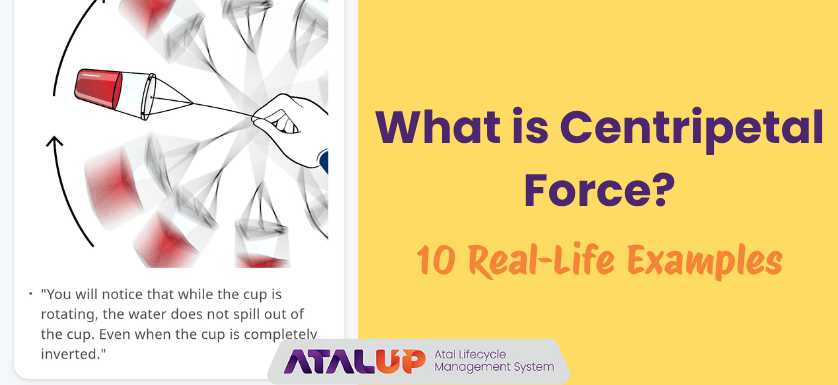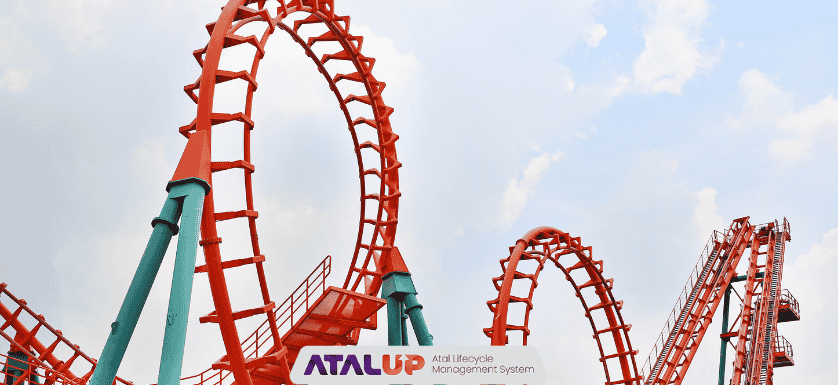
Physics is not just about complex formulas and theories. Many of its principles are part of our everyday life. One such interesting concept is centripetal force. If you’ve ever seen a merry-go-round, stirred sugar in tea, or taken a sharp turn in a car, then you’ve experienced centripetal force without even realizing it.
Let’s first understand the meaning before we dive into daily examples.
What is Centripetal Force?
Centripetal force is a force that pulls or pushes an object toward the center of a circular path. When something is moving in a circle, it does not go off in a straight line because centripetal force is always acting towards the center, making the object follow a curved path.
Now let’s explore 10 simple centripetal force examples that you see around you every day.
10 Real-Life Centripetal Force Examples You See Every Day
1. Car Taking a Turn
When a car takes a turn, it moves along a curved path. The car should technically keep moving in a straight line due to inertia, but it doesn’t. Why? Because the centripetal force comes into play. The friction between the car’s tires and the road provides this force, pulling the car toward the center of the turn. Without this force, the car would slide outward and possibly skid off the road.
2. Washing Machine Spin Cycle
Have you noticed how clothes stick to the sides of the washing machine drum during spinning? This happens due to centripetal force. The drum moves in a circle, and the clothes are pulled inward to follow that path. Meanwhile, the water, which is not attached, gets thrown out through the holes in the drum. This is how the spin cycle helps remove water from clothes using the power of centripetal force.
3. Swinging a Stone on a String
If you tie a small stone to one end of a string and swing it in a circle above your head, you are applying centripetal force. Your hand keeps pulling the stone toward the center of the circle. If the string breaks suddenly, there is no more inward pull, and the stone will fly off in a straight line. This is a classic and easy way to see centripetal force in action.
4. Planets Orbiting the Sun
The planets in our solar system move around the sun in circular or elliptical orbits. What keeps them from flying away into space? It is gravity. The gravitational pull from the sun provides the centripetal force that keeps the planets on their path. Without this force, the planets would drift off in a straight line. This is a large-scale example of centripetal force in space.
5. Roller Coaster Loops
When you ride a roller coaster and it goes through a loop, you feel like you are being pushed into your seat, especially at the top of the loop. At that moment, the track is applying a force toward the center of the loop. That inward force is the centripetal force keeping the roller coaster attached to the track and moving in a circle.

6. Children on a Merry-Go-Round
On a spinning merry-go-round, kids must hold the bars tightly. The ride spins in a circle, and the bars provide the necessary force to pull the kids inward so that they do not fly off. If they let go, they could fall outward due to the absence of that inward pull. Again, the pulling force from the bar is the centripetal force.
7. Cycling Around a Curve
When a person is cycling and comes to a curved road, they usually lean toward the inside of the curve. This helps them balance the forces acting on the cycle. The tires grip the road and provide the friction needed for the turn. This friction acts as the centripetal force, guiding the cycle to follow the curve smoothly.
8. A Ball in a Sling or Circular Pouch
Some traditional Indian games use a ball inside a cloth or sling. When you rotate it in circles before throwing it, your hand and the sling keep pulling the ball inward. This pulling force is the centripetal force. The moment you let go, the ball leaves the circular path and moves in a straight direction.
9. Stirring Tea or Soup
This is one of the most common centripetal force examples. When you stir sugar in a cup of tea or soup with a spoon, the liquid begins to swirl in circles. The spoon’s movement applies force that pulls the liquid inward, helping it follow a circular path. This force is a daily-life version of the centripetal force that helps mix the liquid evenly.
10. Earth’s Rotation and Gravity
As the Earth spins on its axis, gravity pulls everything toward the center of the planet. This inward pull allows everything on the Earth’s surface to stay grounded. At the same time, the rotation tries to push things outward. It is the balance of gravity (which acts as a centripetal force) and the Earth’s spinning motion that helps maintain stability.
Learning Science Through Real Experiences at Atal Tinkering Labs
Understanding centripetal force in theory is good. But seeing it with your own eyes and experimenting with it is better. That’s exactly what Atal Tinkering Labs (ATLs) allow students to do.
ATLs are special innovation labs set up in schools under the Atal Innovation Mission. These labs give students the tools and space to build projects, experiment with scientific principles, and develop problem-solving skills. Students can create simple setups to demonstrate centripetal force, like rotating models or pulley systems. They learn by doing, which makes learning more fun and meaningful.
Not just physics, but students also explore electronics, robotics, coding, and creative thinking. These labs create a culture of curiosity and innovation in Indian schools, especially among young minds.
How ATALUP Helps Schools Run ATLs Effectively
Setting up and running an ATL is not easy. It involves a lot of steps, planning, and ongoing activities. That is where ATALUP comes in. ATALUP is a smart platform that helps schools apply for ATL grants, manage daily operations, plan STEM activities, and track learning progress. It ensures that the ATL lab is not just built, but also used to its full potential. With ATALUP, schools can make STEM learning more structured, efficient, and impactful.
ATALUP has also launched an app where students can learn STEM with household items.
Download the app now
Android: Play Store and iPhone: Apple Store
Final Thought:
Centripetal force examples are all around us, and science becomes more exciting when we see it in our daily lives. Platforms like ATALUP and initiatives like Atal Tinkering Labs ensure that our classrooms are not limited to books but are filled with exploration, experiments, and creativity.